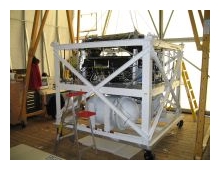|
Checking connectors and an interview with the Antarctic Sun
After TIGER's first Antarctic flight in 2001 - 2002, we
learned a great deal about what it's like to recover a payload in
Antarctica. Our mechanical engineer and "payload recovery
specialist," John Epstein, learned the hard way that when a balloon
payload lands out on the Ice, it doesn't
always just parachute down peacefully awaiting an orderly
recovery. Since balloon payload recoveries down on the Ice almost
always require the use of a twin otter,
this adds another dimension to engineering balloon-borne particle
detectors.
The gondola that houses TIGER was fortunately
designed to be robust enough to withstand the force of a 65-mile drag
across the ice. In fact, the only major components that were
destroyed after the last flight were one of our 192 photomultiplier
tubes and the entire hodoscope (the ends of each hodoscope plane had to
be cut off to be loaded into the twin otter). In addition, the
wiring scheme from TIGER 2001 was
such that it was necessary to cut many high-voltage and signal cables
in order to dismantle the instrument and load it into the twin
otter. The wiring scheme for TIGER
2003 was redesigned to eliminate some of the need to cut these
cables during recovery by making the instrument more modular.
Module 1 is made of the top two scintillators and the top hodoscope(S1,
S2 and HT), module 2 is made up of the two Cherenkov boxes (C0 and C1),
and module 3 is made up of the bottom two scintillators and the bottom
hodoscope (S3, S4 and HB). Each module was designed to be an
independent unit, with no wires entangled, so that they can be removed
one by one in the field. In practice, it was difficult to
maintain this design for modules 2 and 3, but module 1 has remained a
totally independent unit. This is desirable in one way since it
will be necessary to remove module 1 when inserting the aerogel on the top of the
C0 detector.
|
|
Removing
module 1 was also important today so that
Dana could check to make sure that our fragile, vacuum-safe
high-voltage connectors did not come loose while TIGER was being
shipped down to Antarctica.
After dinner, I had a meeting with Kris Kuenning,
one of the reporters for the Antarctic Sun, the only newspaper
published in
Antarctica. She is doing a story on the TIGER / ANITA / ARIA
project that is scheduled to be printed on Sunday. We met in the
coffee shop and talked about cosmic-ray physics and the benefits of an
experiment like TIGER. I think the interview went well. We
were even joined later by some other people and got a good game of
Yahtzee going before I headed off to bed.
|

|




